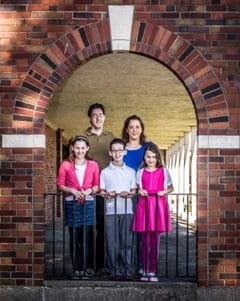The Challenge: Heart Muscle Disease
In 1994, nursing student Laura Baker had a racing heart, and daily walks to class left her very tired. At first, she thought little of it — she was 20 years old, and didn’t think that she could have a heart problem — but as her symptoms continued she realized she needed to see a doctor.
Tests showed cardiomyopathy, or heart muscle disease, which causes the heart muscle to become large, thick, or stiff, and less able to pump blood to meet the body’s needs.
Laura’s condition was mostly stable for several years. She had some challenges along the way, including a serious heart rhythm problem after her second pregnancy.
Laura stayed active, working and caring for her three children, even running several half-marathons in 2012 and 2013.
In 2014 Laura’s health took a dramatic turn for the worse. She had symptoms of acute heart failure and needed a transplant. Because of her blood type, her doctor told her she could be on the transplant wait list for a year or more.
The Path to the UPMC Heart Transplant Program
Laura — a resident of western New York — hoped to stay at home with her children until her transplant, instead of living in a hospital during the wait. She looked for an experienced transplant center that could help her do so.
After a phone call with a transplant coordinator at the UPMC Heart Transplant Program, Laura and her husband came to Pittsburgh for an evaluation.
“I was very nervous,” Laura says. “But the transplant team put me at ease. They cared about me, not just about my heart.”
After the evaluation, Laura and her husband felt that UPMC was the best choice for her care. She joined the transplant list and returned home, but found herself back in Pittsburgh in critical condition a few weeks later. Her medicine had stopped working, and Laura’s heart function was dangerously low.
The Solution: LVAD — A Bridge to Heart Transplantation
Laura’s doctor explained that she needed an LVAD (left ventricular assist device) to provide a longer-term solution while she waited for a new heart. She was opposed to it at first, thinking that an LVAD took away her chance for a transplant.
“I’d learned about LVADs only as a destination for heart failure, not as a bridge to transplant,” Laura says.
With destination therapy, an LVAD is used instead of a heart transplant. With bridge to transplant therapy, an LVAD takes over for the heart until a transplant can take place.
Laura agreed to the LVAD and relocated to Pittsburgh to wait for her transplant. Her husband and mom took turns staying with her, and her children visited as often as they could.
One evening, with dinner in the oven, Laura got the call: a heart was available.
Laura underwent a transplant in November 2014, and today, she says she feels good. She wants other transplant patients to know that it’s important to ask questions, to learn as much as possible, and to understand all of their options for treatment.
“It’s your life,” Laura says. “You have to be your own advocate. You need to look at all of your options for treatment, and make an educated decision about what’s best for you.”
While Laura hasn’t gotten back to running just yet, she hopes to run a full marathon someday, especially in Pittsburgh. She enjoys time with her family and is turning her passion for sewing into a small business.
Laura's treatment and results may not be representative of similar cases.
Read more heart transplant patient stories
Learn More About Heart Transplant
UPMC HealthBeat Blog:
















